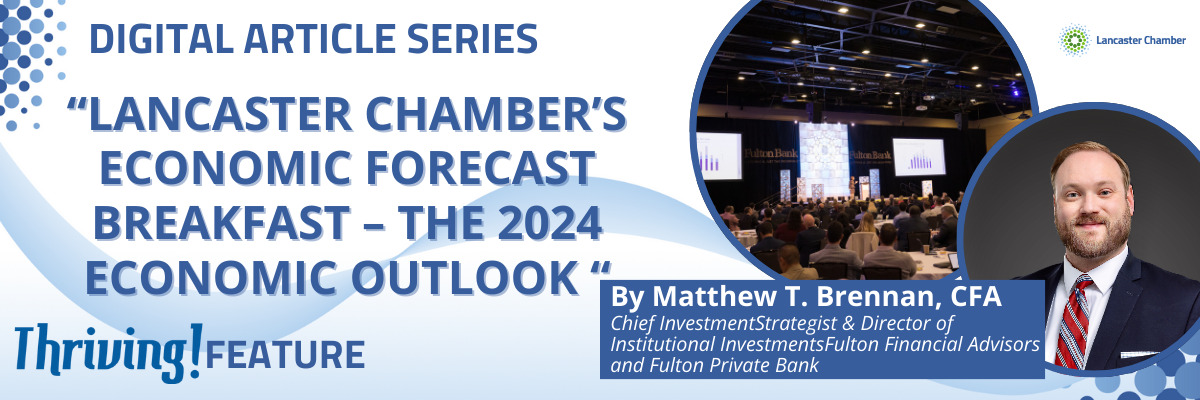By Matthew T. Brennan, CFA® Chief Investment Strategist & Director of Institutional Investments, Fulton Financial Advisors and Fulton Private Bank
A feature piece from our Spring 2024 issue of the Lancaster Thriving Publication.
The crux of the message delivered at the 2023 Economic Forecast Breakfast was that the local economy is strong and the current environment is decidedly rosy, but Lancaster County also faces some significant challenges to growth we must be navigate in the years ahead. 2023 saw local consumer sentiment increase markedly, diverging significantly from sentiment trends across the country as a whole, which have remained at muted levels. Lancaster County residents feel much better about the local economy for good reason. We have a well-diversified economy, ranking as one of the top 15 Metropolitan Statistical Areas (MSA) in the Northeast for manufacturing, but the country also has strong hospitality, health, and education sectors. Lancaster County has among the lowest unemployment rates of any county in Pennsylvania, and the current jobless rate remains well below the national average. Population growth, while not strong on an absolute basis, has been better than the state as a whole and higher than the level seen across much of the Northeast region. GDP growth has been solid, well above the growth rate of the state but slightly below the national rate. All told, there is much to be proud about when it comes to the local economy – Lancaster County continues to stand out among peers.
But while there is much to feel good about, Lancaster also faces several challenges that must be managed in the years ahead to keep the economy growing and thriving. The first noteworthy challenge is a continuing labor shortage, a quandary faced by a wide variety of businesses in the community. Despite growth in the local labor supply that sits above the national average and exceeds the growth rate for Pennsylvania as a whole by 10%, the number of unemployed workers is hovering around the record low for the county. We have seen a material shift in the composition of the labor force over the last 15 years, with significant growth in the Health Care/Social Services and Transportation/Warehousing sectors, which has been somewhat offset by contraction in Manufacturing and Retail Trade. This has created a slight imbalance in the labor market, widening the mismatch between available jobs and the skills of the population available to fill these roles.
The second major challenge is housing supply. Lancaster has among the lowest vacancy rates of any MSA in the country, lower than 95% of metro areas in the U.S. This increases the cost of housing and limits our ability to continue to grow the labor force in the manner needed to alleviate shortages in the labor market. The challenge is fairly simple – our population can’t grow if we have nowhere for new residents to live. Lancaster would need to build an additional 12,000 housing units just to match the median vacancy rate across the country.
Industry faces a similar challenge. The vacancy rate for industrial space is estimated to be below 3% locally. While the sector has slightly contracted in recent years, industrial/manufacturing remains a key driver of economic growth for Lancaster, and we are significantly constrained for expansion space. Our primary focus does not need to be attracting new employers to the area, but rather helping the businesses that are already here continue to expand and grow.
Finally, the fourth challenge we face is an infrastructure system (transportation, water/sewer, broadband) rapidly approaching or at full capacity. This challenge is exacerbated by the sheer number of municipal entities involved. Across Lancaster County, the local infrastructure is owned and controlled by 60 different municipalities and 40 different water and sewer authorities, creating issues and inefficiencies when it comes to long-term planning and expansion. Local infrastructure capacity needs to continue to expand to meet the demands of a growing population and economy – failure here will act as a limiter on future growth.
Despite these headwinds, the local economy remains strong. Addressing these problems in the years ahead will be crucial to the future economic growth prospects of the county, but successfully navigating these known issues will pay dividends for the health of the local economy for years to come. And there is no doubt – Lancaster is up to the challenge.
not secure

